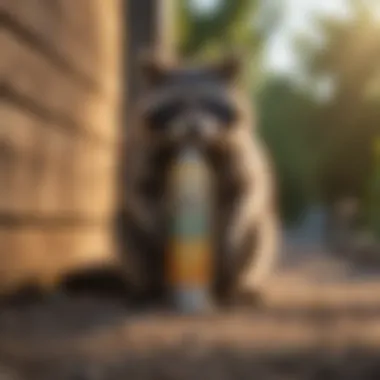Raccoon Deterrents: Home Remedies for Prevention


Intro
Raccoons, with their striking masks and nimble paws, are often seen as cute but can quickly turn into troublesome guests on your property. Their intelligence and adaptability make them experts at foraging for food, rummaging through trash cans, and even nesting in attics. In many residential areas, homeowners find themselves looking for effective ways to manage these curious critters.
Understanding raccoon behavior is crucial for effective prevention strategies. This article will explore home remedies for deterring raccoons, offering savvy solutions that won’t harm the environment. The aim is to equip homeowners with practical knowledge and eco-friendly tactics to keep raccoons at bay while considering the nuances of wildlife management.
This informed discussion will focus on a few key areas: understanding the nature of raccoons as pests, various preventative techniques for home and garden, and a look into sustainable, natural pest control methods. Whether you are dealing with a full-blown invasion or simply want to ensure your property remains raccoon-free, these insights will be beneficial.
Understanding Raccoon Behavior
Understanding raccoon behavior is key for homeowners whose properties might attract these clever creatures. These nocturnal bandits have a unique set of social structures, dietary preferences, and territorial instincts that make them both fascinating and sometimes troublesome for those who wish to keep them at bay.
Recognizing how raccoons behave can inform your preventative strategies. It’s not enough to just place a trash can in a secured area; insight into their habits can help you identify potential entryways and food sources. This understanding allows for tailored deterrents that are effective and impactful.
While raccoons may seem like pesky invaders, they play a vital role in our ecosystems. They are both opportunistic feeders and highly social animals. Acknowledging these characteristics might allow homeowners to find a balance, reducing unwanted encounters while still being conscious of wildlife's role in our neighborhoods.
Social Structure and Habits
Raccoons display fascinating social structures. They are typically solitary animals, but they can sometimes share their territories when resources allow. This adaptation is particularly prominent in urban areas, where food sources are plentiful. You might find them roaming in pairs during the breeding season or when mothers are raising their kits. Such social dynamics can lead to increased visibility of these creatures around your home.
A raccoon tends to explore areas with a level of curiosity that often leads them to various residential spaces. They are intelligent critters with the ability to remember places where they've found food. This knack for problem-solving can make them formidable opponents.
Dietary Preferences
Raccoons are notorious for their varied diets. They are omnivorous, which means they have a taste for just about everything. From pet food left outside to berries in your garden, a raccoon’s diet is broad enough to encompass many different food sources. This gastronomic flexibility is what makes them so adaptable.
Homeowners should be vigilant about cleaning up after meals and securing everything from compost bins to bird feeders. A leftover pizza crust can easily draw them in, while open garbage bins can become a feast for an ambitious raccoon. Their dietary habits are directly tied to the level of attraction they may find in your yard.
Territorial Behavior
In terms of territory, raccoons are rather interesting. An adult raccoon typically claims a home range of about 5 to 30 acres, depending on the availability of food and shelter. They are also known to have overlapping ranges with other raccoons, leading to a unique cohabitation situation, especially in more densely populated areas.
Raccoons are nocturnal, meaning they are most active at night. During this time, they will patrol their territory, looking for opportunities. Homeowners might hear nocturnal scuffles or chattering, especially if there are multiple raccoons scavenging in the same area. If you're hearing more than usual, it could be an indication of an expanding raccoon population nearby.
Understanding these traits can provide you with insights into why raccoons choose your property and how you can adjust your own habits to better deter them.
By learning about raccoon behavior, homeowners can implement more effective measures in deterring these crafty animals. Realizing what attracts them, how they live, and their social dynamics can lead to wiser choices in preventing unwanted interactions.
Common Signs of Raccoon Presence
Recognizing the common signs of raccoon presence is crucial for homeowners who want to maintain a peaceful living environment. Raccoons are clever creatures, often adept at hiding their tracks. Therefore, understanding the indicators of their activity not only helps in taking preventive action but also in understanding the scale of the potential issue. Being proactive can save homeowners from significant property damage and disturbances, which may arise from raccoons making themselves at home under your deck or in your attic.
Physical Evidence in the Yard
The yard can be the stage for various telltale signs that raccoons have paid a visit. One of the most noticeable signs is disturbed soil or overturned plant pots. Raccoons, with their clever paws, dig through gardens in search of insects, roots, or tubers. You may find clumps of dirt scattered around or plants that are unnaturally displaced.
Additionally, you might spot paw prints; those little, hand-like imprints can tell you exactly who has been wandering around. They are about 2 to 4 inches wide and have five toes, often resembling little hands. Searching for these prints, especially near water sources or trash bins, can provide clues on whether raccoons are frequent visitors.
Other signs include feces which are often found in areas where they are foraging. The droppings can contain remnants of fruit, seeds, or even shiny bits of plastic, depending on their diet. Spotting feces can confirm their presence and indicate where they are feasting on your property.
Noise Indicators
Raccoons are not just out for a stroll; they are quite vocal, especially during their active hours, often nocturnal. If you hear scratching sounds coming from your attic or sounds of something knocking over and clattering outside, you might be dealing with raccoons. These sounds can be quite distinct, and for a vigilant homeowner, they serve as a red flag to investigate further.
Additionally, if you hear chattering or whining noises during the night, especially noises that seem to be grouped, it might signal a raccoon family. Juveniles often make these sounds, and their presence can be the tip-off that an entire litter may be set up in your vicinity.
"Understanding the sounds raccoons make is as vital as knowing the signs they leave behind. Each noise can pinpoint their level of comfort or distress in your space."
Damaged Property Overview
When raccoons set up shop, the evidence becomes difficult to ignore. Homeowners often notice damaged fencing, which may consist of torn or broken wood. Raccoons are notoriously good climbers and can easily scale fences or loose boards to reach what they want. If your fence looks like it’s been through a squabble, raccoons may be the culprits.
Another indicator is damaged rooftops or shingles. Raccoons often find entry points through soft spots in the roof, causing leaks or further property damage. If you spot dislodged shingles or areas of your roof that have unusual wear, it could be a sign of these critters attempting to make themselves comfortable upstairs.


In summary, maintaining an awareness of these signs can help you in teasing apart the raccoon-riddled fabric of your surroundings. Taking the right steps at the right time can effectively deter these clever and curious creatures from overstaying their welcome.
Preventive Measures for Homeowners
When it comes to raccoon control, homeowners can take substantial steps to prevent encounters with these clever critters. Prevention is always more effective than a cure, and implementing proactive measures is key to maintaining a peaceful home environment. It not only protects your property but also fosters a sense of security. By understanding how raccoons interact with their environment, homeowners can tailor strategies that specifically deter these animals.
Securing Garbage Bins
One of the primary attractants for raccoons is garbage. Raccoons are notorious for rummaging through trash cans in search of food. Therefore, securing garbage bins can significantly reduce the chances of these animals paying a visit.
- Use bear-proof bins: Investing in bear-proof containers can be a solid option. These are designed to keep even the most determined critters out.
- Add weight: If securing bins isn't an option, placing bricks or heavy objects on top may deter their attempts to tip them over.
- Regular disposal: Make it a habit to dispose of trash more frequently, particularly after events or gatherings that produce extra waste. This minimizes the time that your garbage is accessible.
"A clean yard is a clear message to raccoons: there's nothing tasty here!"
Closing Entry Points
Raccoons are quite dexterous, frequently slipping through openings that seem inconsequential to us. It is thus imperative for homeowners to identify and close potential entry points in their houses and yards.
- Inspect structures: Regularly check areas like vents, gaps in siding, or holes in fences. Raccoons can fit through surprisingly small spaces.
- Secure chimneys and attics: These spaces often serve as inviting dens for raccoons. Install mesh screens or caps to block access.
- Reinforce fences: Ensure that fences reach the ground, and if necessary, bury the bottom of the fence a foot deep to thwart digging.
Using Fencing Effectively
Fencing can serve as an effective barrier against raccoons, but not every type of fence does the trick. It’s essential for homeowners to consider the design and material of the fence when attempting to deter wildlife.
- Height matters: Raccoons are agile climbers. A fence that’s at least 4 to 5 feet tall can help keep them out.
- Add an overhang: Installing an overhang at the top of the fence can prevent raccoons from climbing over. A simple angled addition can make all the difference.
- Use the right materials: Opting for sturdy materials that can withstand digging attempts is crucial; avoid wooden fences that raccoons might gnaw through.
By following these preventive measures, homeowners can build a strong defense against the persistent raccoon population. It’s a collaborative effort that combines proper education with practical steps to keep their homes safe.
Natural Deterrents
The topic of natural deterrents is essential in the context of keeping raccoons away from your living space. These methods not only offer effective solutions but also align with an eco-friendly approach. The idea is to use substances readily available in nature that can create an unwelcoming environment for these clever creatures. Raccoons are resourceful and adaptive, making them challenging to deter. However, employing natural solutions can help mitigate their presence without harming them or disrupting the local ecosystem.
One of the key benefits of using natural deterrents is that they are generally safe for both humans and pets, unlike some chemical options that may pose risks to family members or neighboring wildlife. Furthermore, the use of these measures promotes a sense of responsibility towards urban wildlife management, reflecting a balance between preserving nature and protecting one’s home.
Essential Oils and Their Applications
Essential oils have gained a reputation as effective deterrents thanks to their strong scents. Raccoons possess keen senses, particularly their sense of smell, which can be utilized against them. Oils like peppermint, eucalyptus, and orange can be sprinkled or sprayed around areas prone to raccoon activity.
- Peppermint oil - This oil is particularly potent; its sharp aroma can disorient raccoons and deter them from approaching a treated space. Mixing a few drops of peppermint oil with water and spraying it around waste bins or patios can make a noticeable difference.
- Eucalyptus oil - The strong, menthol-like scent may not only repel raccoons but also other potential pests. This oil can be applied similarly to peppermint oil for potent results.
- Orange oil - Generate a solution with orange oil, as raccoons are known to dislike fruity scents. An added benefit is that it is a more pleasant scent for humans too!
In using these oils, it’s important to reapply them frequently, especially after rain, to maintain their effectiveness. As with any remedy, observe how well it works and remember that persistence is key.
Spicy Substances as Deterrents
Spices can add both flavor and a strong deterrent effect to your defense strategy against raccoons. Ingredients such as cayenne pepper, chili powder, and even garlic powder can make areas unattractive to raccoons because they dislike the pungent flavors. When they encounter these substances, they are likely to turn tail and avoid the area in the future.
- Cayenne pepper - Sprinkling cayenne around garbage bins or garden areas can thwart their foraging efforts. The heat is not just for taste; it acts as a powerful repellent.
- Chili powder - Similar to cayenne, using chili powder can create an uncomfortable experience for raccoons, particularly if they get it on their paws or face.
- Garlic powder - This is another option that can serve as a natural deterrent, creating an unpleasant zone they will tend to dodge.
Mixing these spices with water to create a deterrent spray can maximize their effectiveness. However, regular reapplication will be necessary to keep the barriers intact.
Plant-Based Solutions
Another consideration in the realm of natural deterrents is planting specific flora. Certain plants are known to ward off raccoons due to their scent or taste. Here’s a quick run-through of plant-based options that can be incorporated into your landscaping:
- Lavender - The strong fragrance of lavender is pleasant to humans but can act as a turn-off for raccoons. Placing lavender near entry points may help in reducing their visits.
- Coleus canina - Often called the ‘Scaredy Cat Plant’, it’s known for its ability to repel not just cats but raccoons as well. Its distinct smell is off-putting to them.
- Thorny shrubs - Planting thorny varieties like hawthorn or barberry can create a physical barrier as well as a psychological one. Raccoons would rather not risk injury when seeking food from your yard.
By blending aesthetics with functionality, these plants can maintain the beauty of your property while acting as barriers against unwelcome guests.
"Using natural deterrents not only establishes a barrier to raccoons but also fosters a responsible approach to wildlife care and neighborhood aesthetics."
Incorporating these natural solutions into your home protection strategy can promote a raccoon-free environment while staying true to eco-friendly practices. All in all, consistency is crucial. Regularly assess the effectiveness of these methods and adapt them to suit your environment.
Mechanical Deterrents
In the realm of guarding your home against raccoons, mechanical deterrents emerge as practical allies. These strategies integrate simple mechanics to create effective barriers and obstacles. By leveraging motion, sound, and light, homeowners can deter these clever critters without resorting to harmful chemicals or invasive tactics. Their primary benefit is the ability to minimize unwanted raccoon encounters while allowing humans to maintain a hands-off approach to wildlife management. Understanding and implementing these devices can greatly enhance your overall pest control efforts without compromising safety or ethics.


Motion-Activated Sprinklers
Motion-activated sprinklers are a nifty solution that can startle raccoons before they even set a paw on your property. Imagine a stealthy raccoon, tiptoeing around, when suddenly, out of nowhere, a jet of water shoots across its path. Not only does this grab their attention, but it often sends them scurrying away. These devices utilize infra-red sensors to detect movement, unleashing bursts of water that can discourage raccoons from approaching your garden or trash areas.
One primary advantage of using motion-activated sprinklers is that they are eco-friendly—running on a typical hose setup—and pose no harm to either the animals or your landscape. Just make sure they are installed in proper locations where raccoons are known to roam. Plus, you might gel that added benefit of a refreshed garden too!
Noise-Making Devices
On a slightly different note, noise-making devices introduce an audio component to raccoon deterrence. These gadgets can emit sounds that are unsettling to raccoons. Think of it as a sonic defense system that interrupts their natural curiosity and induces a sense of discomfort. High-pitched sounds or random noises can mimic the environment’s threats, compelling raccoons to reconsider their plans.
Placing these devices near entry points or areas frequently visited by raccoons can amplify their effectiveness. Although this mechanical solution relies on auditory cues, be mindful of your neighborhood; excessive noise may not win you rave reviews from the neighbors!
Motion Sensors and Lights
Combining both motion detection and illumination, motion sensor lights serve to dissuade raccoons effectively. When these clever creatures approach, the sudden burst of light can be enough to throw them off their game. Many people find raccoons to be nocturnal nomads, often lurking in the shadows. By erecting lights that turn on upon sensing movement, you can expose them and shine a less-than-welcoming beacon over your lawn and backyard.
These devices come in various forms—some even boasting solar technology. It can be handy, especially in conserving energy. While installation is usually straightforward, consider covering the lights from frequent rains or using waterproof models to avoid potential damage.
"Mechanical deterrents are not just tools, they are a commitment to maintaining a harmonious coexistence with wildlife while fostering a secure home environment."
In summary, incorporating mechanical deterrents, whether through the element of surprise in water, sound, or strategically placed light, can help significantly reduce the chances of raccoons entering unwanted areas. These methods not only promote a raccoon-free house but are often friendly to the environment and surrounding wildlife.
Chemical Solutions and Their Considerations
Addressing raccoon issues often leads homeowners to consider various chemical deterrents. The idea here is straightforward: harness the power of chemicals, specifically formulated not just to chase away raccoons but to prevent them from viewing your yard or home as an inviting sanctuary.
But, in the quest for an effective means of discouragement, it’s crucial to be aware of both the benefits and the considerations linked to these solutions. Understanding the balance between efficacy and safety becomes a cornerstone of an effective raccoon deterrent strategy, especially if pets or children share the space.
Commercial Deterrent Sprays
Commercial deterrent sprays find their way into many homes as they promise a quick, easy solution for raccoon control. These sprays are often made from natural ingredients or specific compounds that raccoons find repugnant. Many homeowners report success using sprays infused with the likes of predator urine, citrus, or even strong-smelling extracts that signal danger to the raccoons and send them packing.
Here are a few examples of popular commercial deterrent sprays:
- Critter Ridder: Blend of essential oils that drive away raccoons.
- Raccoon Repellent: Specifically designed formula for pest repelling.
- Nature’s Mace: Known for its natural, safe composition.
However, it’s worth noting that while these sprays can serve as the first line of defense, their effectiveness can fluctuate based on weather conditions and the individual animal's persistence. Many find that continual application throughout the year—especially after rain—is necessary.
Potential Risks of Chemicals
While the convenience of chemical solutions is tempting, homeowners must tread carefully. Risks can range from environmental hazards to unintended consequences for other wildlife and domestic animals.
For instance, some commercial products contain ingredients that, while effective at deterring raccoons, may also be harmful to beneficial insects or pets. Homeowners should pay close attention to the labels, ensuring the product remains safe for their particular situation. Moreover, overreliance on chemicals can potentially lead to desensitization of the raccoons, meaning what initially worked may become ineffective over time, igniting a cycle of desperation and increased chemical application.
Comparative Efficacy Analysis
Nothing feels more reassuring than making informed choices based on solid data. In the realm of raccoon deterrents, comparing the efficacy of various commercial deterrents opens a window into what works best under different circumstances. A quick glance might reveal:
- Natural sprays vs synthetic: Natural sprays, while eco-friendlier, might need to be reapplied more often than their chemical counterparts.
- Local climate effects: Those residing in humid areas may find some solutions evaporate quicker, necessitating careful selection based on local weather patterns.
Engaging with community forums, like Reddit discussions or localized Facebook groups, can provide personal anecdotes to help inform decisions. User experiences often shine a light on real-world effectiveness that standard marketing material simply cannot provide.
In the world of pest control, knowledge is power. A well-informed homeowner is a successful one.
Long-Term Strategies for Raccoon Control
Raccoons, with their clever antics and adaptable nature, can become a persistent nuisance for homeowners. To truly deter these resourceful creatures, it's essential to adopt long-term strategies that not only provide immediate relief but also address the underlying conditions that attract raccoons to your property. Implementing such strategies helps safeguard your home and fosters a more harmonious coexistence with local wildlife.
Habitat Modification Techniques
Modifying the habitat around your home is critical in preventing raccoon intrusions. Here are some specific techniques you might consider:
- Eliminate Food Sources: Ensure that pet food is kept indoors, and bird feeders are removed at night. This deprives raccoons of easy meals.
- Seal Off Shelter Areas: Raccoons are notorious for seeking out cozy, hidden spots to make a home. Inspect your property for potential shelters, like hollow trees, sheds, and under decks. Make sure to properly seal these places.
- Maintain Landscaping: Trim shrubs and trees that are close to your home to reduce access points. Raccoons can be surprisingly nimble climbers, so the less they have to work with, the better.


As a result of these modifications, not only will you deter raccoons, but you’ll also create a cleaner and safer environment for other wildlife.
Community Awareness Initiatives
Addressing raccoon issues is rarely a solo endeavor. Communities often share the same challenges, prompting the need for awareness initiatives:
- Neighborhood Education: Organize community meetings to discuss raccoon-related concerns. Share best practices and preventive measures among neighbors.
- Local Wildlife Groups: Collaborate with local wildlife conservation organizations to create informational pamphlets or workshops, focusing on understanding local wildlife needs.
- Social Media Outreach: Utilize platforms like Facebook or even Reddit to share tips, stories, and resources. Building a neighborhood group focused on wildlife can foster a supportive environment for all.
These initiatives not only create a well-informed community but also establish mutual reinforcement in raccoon prevention.
Integration with Local Wildlife Sociologies
Understanding the broader ecological context is crucial in ensuring effective long-term control of raccoons. Here’s how to approach this:
- Engage with Ecologists: Consult local ecologists or wildlife biologists to understand raccoon behaviors and their role in the ecosystem. Such insights can lead to innovative prevention methods.
- Support Sustainable Practices: Advocate for community practices that promote biodiversity and wildlife health. For example, planting native species will not only enhance the local environment but also potentially attract other animals, maintaining a balanced ecosystem.
- Monitor Raccoon Populations: Work with local agencies to track raccoon populations. Understanding their numbers can help tailor approaches in real-time and develop strategies that are adaptive as situations evolve.
By weaving these strategies into the fabric of your home and community, you are not just fighting against raccoons. You are embracing a more thoughtful way of managing wildlife interactions while securing your residence.
"A stitch in time saves nine." Taking action today can obviate greater troubles down the road.
Maintaining a Raccoon-Free Environment
Keeping your home free from raccoons is not just a matter of convenience; it’s a crucial aspect of maintaining a safe and peaceful living space. Raccoons can pose significant risks to both your property and health, so establishing a plan to deter them is vital. Regular maintenance and proactive strategies can greatly reduce the chance of these clever creatures taking up residence in your garden or attic.
Regular Inspection Practices
One of the cornerstones of keeping raccoons at bay is regular inspection of your property. Making it a habit to thoroughly check for any signs of intrusion can prove beneficial in the long run. Look for potential entry points like gaps under doors or around windows. Additionally, inspecting your garbage bins and outdoor storage for signs of tampering can alert you to raccoon activity before it becomes a bigger problem.
- Inspect your Garbage Bins: Ensure that lids are secure and check for claw marks or scattered contents.
- Examine Entryways: Regularly look for loose siding, cracked windows, or holes in the roof that might give raccoons a way in.
- Monitor your Garden: Notice if there are any disturbances in your plants, which might hint at nocturnal visits.
By taking these small but impactful steps, you can identify and address issues before they escalate into a raccoon invasion.
Seasonal Adjustments in Prevention
As the seasons change, so do the behaviors and needs of wildlife, including raccoons. Adjusting your prevention strategies according to the season can enhance your defenses against these animals. For instance, in spring and summer, raccoons are often drawn to gardens for fresh food sources.
- Make Seasonal Modifications: In the warmer months, consider using barriers like fencing specifically designed to keep out raccoons. Ensure to plant deterrent herbs like mint or lavender.
- Winter Preparations: As the temperature drops, ensure that your property remains sealed and secure, as raccoons will seek warm shelter. Inspect your attic and basement for any access points they might exploit.
- Adapt Garbage Practices: Change your disposal habits according to the season. With the higher likelihood of raccoon activity in warmer months, take out the garbage more frequently and secure it between collections.
This attention to seasonal changes allows you to stay one step ahead, making your home less appealing to raccoons.
Involving Pest Control Professionals
When efforts to maintain a raccoon-free environment seem overwhelming or you’ve encountered a significant problem, enlisting pest control professionals might be necessary. They bring expertise in identifying entry points, assessing raccoon activity, and providing targeted solutions that may not be easy to implement on your own.
- Evaluate the Situation: A professional can offer a thorough inspection of your property, pinpointing areas of concern that may be overlooked.
- Implement Targeted Solutions: Whether it's setting traps or suggesting long-term exclusion methods, their knowledge can facilitate effective action against raccoons.
- Ongoing Maintenance Advice: Professionals can provide continued guidance, recommending seasonal strategies and inspection routines to keep your home secured over time.
While involving pest control can incur costs, the peace of mind and potential savings in damage repair can make it a worthwhile investment.
"A stitch in time saves nine." Taking proactive steps today can prevent a major headache tomorrow.
Closure: Balancing Wildlife and Home Security
In the realm of homeownership, the presence of wildlife, particularly raccoons, can pose significant challenges both to your peace of mind and to the security of your property. The conclusion of this discussion emphasizes the critical balance between protecting our home environments and respecting the broader ecosystem that wildlife, like raccoons, inhabits. This balance not only serves to ensure our safety but also promotes a harmonious coexistence with nature, which is becoming increasingly paramount in urban and suburban settings.
Importance of Responsible Wildlife Treatment
Taking a responsible approach involves several key elements:
- Understanding Raccoons: Recognizing their habits, behaviors, and needs plays a pivotal role in crafting effective deterrents. Knowing why a raccoon might intrude upon your space—be it for food or shelter—can guide homeowners to implement measures that are not only effective but humane.
- Eco-Friendly Strategies: Resorting to chemical alternatives might seem tempting, but often they come with downsides. More natural methods, like using specific plants or deploying motion-sensor lights, can deter raccoons without disturbing the ecosystem.
- Community Engagement: Spreading awareness on how to deal with raccoons can foster a neighborhood of well-informed homeowners. This creates a unified front against raccoon intrusion, which can be more effective than tackling the problem in isolation.
"Wildlife thrives on access and opportunity. By limiting these while caring for their well-being, we can keep our spaces safe without neglecting nature."
Benefits of Balancing Strategies
Adoption of these considerations can lead to several benefits:
- Protection of Property: Effective home remedies and knowledge ensure that your property withstands raccoon invasions.
- Enhanced Community Safety: Reduced interactions with wildlife lower chances of disease transmission and property damage for the entire area.
- Preservation of Biodiversity: By treating urban wildlife responsibly, we contribute to the survival of species that are vital to our ecosystem’s health.
Considerations for Homeowners
As homeowners, it’s vital to remain vigilant while maintaining compassion for our animal neighbors. Integrating strong deterrent methods with an understanding of local wildlife laws and best practices can yield the most sustainable outcomes.



